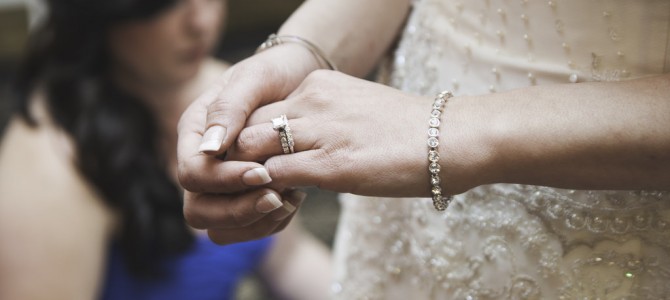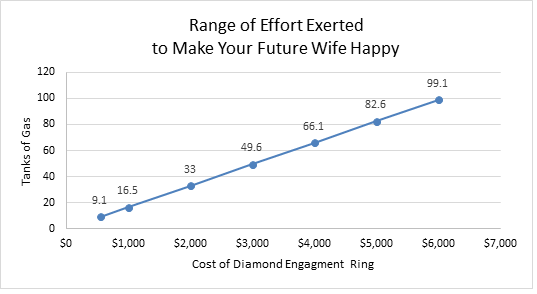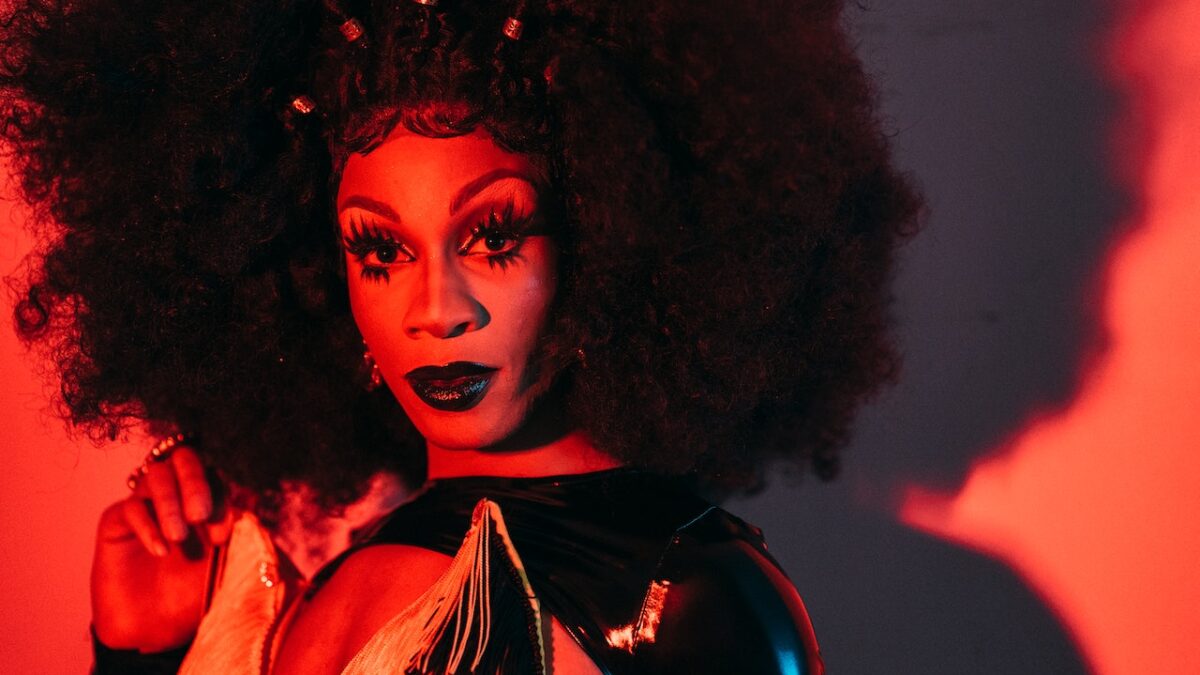
The Week hosted an annual feminist ritual of ruining things that are awesome for women. This time, men are literally shackling women up. That’s right: shackling women in …diamonds. That lovely little sparkler, a traditional part of a marriage proposal, is really latent sexism, you see.
The Federalist has also published two well-stated and logical cases that encourage women to forgo the diamond engagement ring. It makes sense. They cost too much. It’s just an object. What matters most is the marriage.
They are all very thoughtful and logical, except that life doesn’t have to be completely logical or methodical, often because it involves human beings. Certainly, there is some pragmatism in the idea that you wouldn’t want couples forgoing marriage because they thought a diamond ring costs too much. Yet overwhelming majorities of men and women remain convinced that men should propose in a traditional manner. While gender roles today may appear more fluid, successful marriages typically capitalize on the inherent complementary nature of men and women. Marriage as an endeavor means building something greater than one person. It requires commitment, planning and care.
While people deride DeBeers as an evil corporate genius behind making the diamond the symbol of engagements, it’s a free market. Why was DeBeers so successful in its efforts if it’s just a blatant manipulation?
Diamonds Don’t Cost That Much
Buying a diamond, like making a marriage, requires commitment, planning, and care. It’s a gesture to signify you are ready for marriage. Marriage is the commitment to build a life together. Does it not make sense to produce evidence before you enter into such an arrangement that you can build towards something?
Taking deliberate actions towards marriage increases its chances of success
New research shows that how thoughtfully couples make decisions can have a lasting effect on the quality of their romantic relationships. Couples who are decisive before marriage—intentionally defining their relationships, living together and planning a wedding—appear to have better marriages than couples who simply let inertia carry them through major transitions.
This doesn’t mean you need a Jennifer Lopez-size engagement ring (although having Ben Affleck propose to you does appear lucrative). You can demonstrate clear commitment with more of a Costco-priced ring (starting at $549). That’s about the cost of filling up your car with gas nine times.
(The graphic assumes the average price of gas is $3.56/gallon and that you drive a car with a 17-gallon tank.)
 Maybe, just maybe, instead of a vast conspiracy, DeBeers hit upon something that millions of people agree with, and the market rewarded their idea. Marriage is an important and highly visible milestone for people. Why not literally have a stone represent the decision to engage in a lifelong commitment? Having a stone that is rare, precious, and formed deep in the core of the earth through a process not completely understood by science become a symbol for marriage makes perfect sense. Finding your spouse can often feel similarly challenging and mysterious, and is rare occurrence (unless you are Elizabeth Taylor).
Maybe, just maybe, instead of a vast conspiracy, DeBeers hit upon something that millions of people agree with, and the market rewarded their idea. Marriage is an important and highly visible milestone for people. Why not literally have a stone represent the decision to engage in a lifelong commitment? Having a stone that is rare, precious, and formed deep in the core of the earth through a process not completely understood by science become a symbol for marriage makes perfect sense. Finding your spouse can often feel similarly challenging and mysterious, and is rare occurrence (unless you are Elizabeth Taylor).
It shouldn’t be shocking that consumers found appeal in the parallels between diamonds and marriage. Rather, it should be applauded. Marriage is precious and one of the deepest commitments people will make on Earth. People’s alignment with a symbol that expresses those features should be taken as an affirmation of the value of marriage.
Feminists Aside, Women Like Diamonds
Of course, there is the “latent sexism” that arises from women getting their dream diamond ring from their future husband. What an unspeakable evil. Feminism’s odd bent to destroy the numerous upsides to being a woman sure is the oddest way to make things better for women. Typically, one suspects the author of said screeds didn’t get a ring she really wanted so she may be spending more time convincing herself why that’s “okay.” Next thing you can expect is a new war against the oppression of the wedding dress: “Why a flattering cut really undermines your career.”
The real intent of articles that want to strip the glamour and allure of marriage away is to diminish the institution. The ring is just the first problem with marriage. Next it will be marriage itself is a tool of oppression. Oh, wait, that already happened in 2013. Marriage is a tool of colonialism, xenophobia, racism, gendered social control, and more if you understand progressives’ real aims when they seek to chip away at any piece of glamour that makes marriage aspirational.
Progressives’ end-game may yet be mandated asexual garb for both sexes with maximal suppression of any individual desires lest one experience an “inequality” or “latent sexism.” Granted, women don’t have a rational explanation for some of their more feminine inclinations. One can’t explain why twirling in heels can make a woman feel beautiful. Most women, however, don’t seem to find their personal desires a detraction, nor oppressive. In fact, many women appear to enjoy certain feminine pursuits without apology.
When my husband proposed, I never felt that the ring was an exchange for my services. There was no palatable patriarchal force that imprisoned me as the ring slide on my finger. Instead, I saw a man whose effort showed me that he had known for months that I was the one he wanted to spend the rest of his life with. I remember his face more than the ring at that moment, but every day since, when I catch a glance of it, it reminds me of what we are building together.
Could something else besides an engagement ring do that? While some other glamorous symbol could displace the diamond in people’s minds, it remains a demonstration of commitment and faith that a couple’s future holds promise. It also looks quite lovely on one’s hand, and is compact enough to travel with you at all times.
If gathering the initiative to obtain an engagement ring is too overwhelming for a couple, it may be fair to question whether the future challenges they face will be surmountable. Marriage is serious business and should be undertaken with preparation and planning. While to some a diamond seems extravagant, it fills that role because it symbolizes a brighter tomorrow together.
Diamonds Symbolize Marriage, So Don’t Tear Them Down
One of the main contributors of income inequality today is from the marriage gap: “Couples who get and stay married can have as much as four times the wealth of their single or divorced peers. Experts say that’s not only because they can combine their salaries and share expenses once they get married.”
A diamond represents that faith in a future where together you can afford what at that moment exceeds a couple’s monthly budget. Besides, a modern working woman can assist with any future payments after marriage. If a woman feels strongly about wanting to reciprocate the gesture, she could purchase a set of cuff links or a classic timepiece for her man. Latent sexism can be solved without ruining a woman’s dream of a diamond ring.
Asking men to stop proposing with the requisite engagement ring as a symbol for a promise of a bright prosperous future for the prospective couple, even if well meaning, may undermine efforts to promote marriage. To quote Virginia Postrel in “The Power of Glamour”: “glamour became a powerful form of nonverbal persuasion, one that taps into our most secret dreams and deepest yearnings to influence our everyday choices.”
Diamonds as a symbol are part of the glamour and imagery of marriage. Having marriage retain its glamour may aid in buttressing its appeal in a time where many seek to tear it down. Glamour “focuses preexisting, largely unarticulated desires on a specific object, intensifying longing.”
To desire an engagement ring is a part of the inner story that speaks to our yearning for marriage and family. To dismiss diamonds as frivolous ignores how glamour shapes our aspirations and sense of commitment. Making marriage a casual endeavor with little burden of preparation will not strengthen the institution or create more successful marriages. Deglamorizing the institution will only support efforts to discount the importance of marriage.









